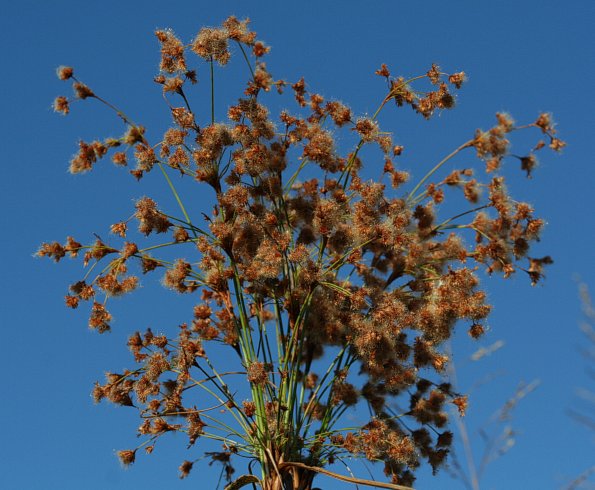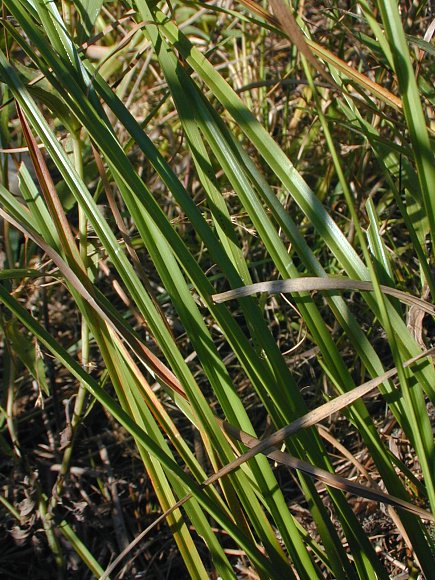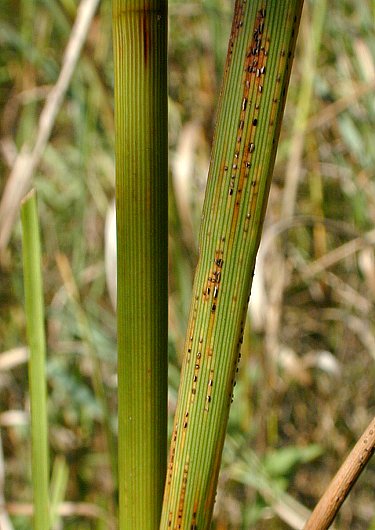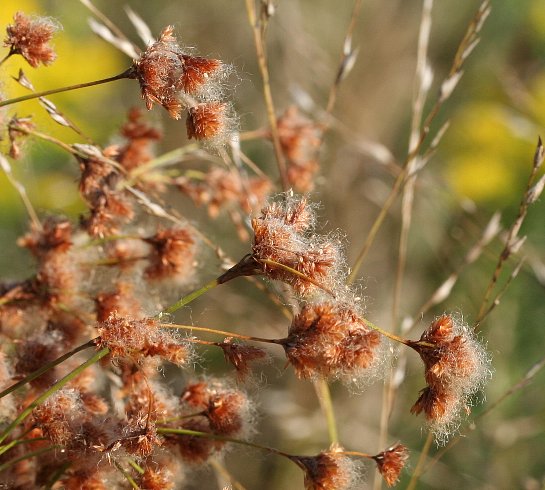Description: This perennial sedge consists of a tuft of low sterile shoots, from which arises one or more taller fertile shoots. The fertile shoots are leafy culms with terminal inflorescences; they are about 3-5' tall. The stout culms of fertile shoots are unbranched, bluntly 3-angled or terete (circular in cross-section), medium green, longitudinally veined, and glabrous. About 5-9 alternate leaves occur primarily along the lower half of each culm. The blades of these leaves are up to ½" (12 mm.) across and 2' long; they are ascending to widely spreading. The blades are medium green, glabrous, and longitudinally indented or furrowed. The leaf sheaths are medium green, longitudinally veined, glabrous, and closed. Sometimes small cross-veins interconnect the longitudinal veins on the culms and sheaths. The leaves of infertile shoots are similar to the leaves of fertile shoots, except the former are somewhat smaller than the latter and more evergreen.

Each fertile culm terminates in an irregular compound cyme of spikelets spanning about 3-6" long and similarly across. This compound cyme has several ascending to drooping branches that are slender, green, and either glabrous or scabrous. These branches terminate in small clusters of 3-12 spikelets that are either sessile or pedicellate (usually the latter). One or more ascending to drooping branchlets originate from many of these spikelet clusters to terminate in either individual or secondary clusters of 2-10 spikelets that are either sessile or pedicellate (usually the latter). These branchlets are similar to the branches of the inflorescence, except they are more slender. Individual spikelets are about 4-7 mm. long, 2.5–3.5 mm. across, and more or less ovoid in shape; they are reddish brown, brown, or blackish brown at maturity and more or less covered with persistent woolly hairs. Each spikelet consists of a dense head of perfect florets and their scales in several overlapping series. Individual scales are about 1.5–2 mm. long, lanceolate to ovate in shape, and brown-membranous. Each perfect floret has a tripartite style, 3 stamens, and an ovary; each floret is partially hidden by its scale. At the base of the compound cyme, there are 3 or more large leafy bracts. Underneath the branched divisions of this cyme, there often occurs much smaller bractlets. The blooming period occurs from late summer to early fall, lasting about 1-2 weeks for a colony of plants. The florets are cross-pollinated by the wind.

Afterwards, the
florets are replaced by tiny achenes that are 0.5–1 mm. long and about
one-half as much across. These
achenes are pale brown, bluntly 3-angled, and pointed at both ends;
each achene is
surrounded by 6 long bristles (or hairs) that are reddish brown, curly,
and
persistent. It is the exerted bristles of the many achenes in the
spikelets that provide them with their woolly appearance. The root
system is fibrous and short-rhizomatous. Wool Grass often forms
colonies of plants.
Cultivation:
The preference is full to partial sun, wet to moist conditions, and
soil that is muddy, sandy, or gravelly. Shallow water is tolerated. The
easiest way to start new plants is by division of the sterile shoots.
Range & Habitat:
The native Wool Grass is occasional to locally common throughout
Illinois (see Distribution
Map). It has been collected less often in the central section
of the state. Habitats consist of both sandy and non-sandy wetlands,
including marshes, swamps, sloughs (seasonal streams), sedge meadows,
gravelly seeps, and borders of ponds. This species is somewhat variable
across its range.

Faunal
Associations:
Insects that feed on Wool Grass (Scirpus
cyperinus) and other bulrushes (Scirpus spp.)
include semi-aquatic leaf beetles (Donacia spp.,
Plateumaris spp.), a weevil (Dirabius rectirostris),
larvae of the Dion Skipper (Euphyes
dion), larvae of the Lost Owlet (Ledaea perditalis)
and other moths, seed bugs (Cymus
spp.), a
plant bug (Teratocoris
discolor), the Chokecherry Aphid (Rhopalosiphum cerasifoliae)
and other aphids, leafhoppers (Limotettix
spp.), and a thrips (Haplothrips
halophilus); see the Insect Table for a
more complete list of these species. Bulrushes are an important source
of food and cover to many vertebrate animals. Many species of ducks and
other wetland birds feed on the seedheads of bulrushes; the Canada
Goose and Trumpeter Swan also eat the foliage. See the Bird Table
for a listing of these species. Because Wool Grass and other bulrushes
often form dense colonies of plants, they provide good nesting habitat
for various species of wetland birds. Muskrats eat both the culms and
rhizomes of bulrushes, while the Meadow Vole eats the seeds.
Photographic Location:
A sandy marsh in Vermilion County, Illinois.

Comments: The common name of this species is misleading because it isn't a member of the Grass family (Poaceae). Instead, it is a member of the Sedge family (Cyperaceae), like other Scirpus spp. To make matters even more confusing, these species are collectively referred to as 'bulrushes,' even though they are not members of the Rush family (Juncaceae). Notwithstanding such problems with nomenclature, Wool Grass (Scirpus cyperinus) is one of the more attractive bulrushes, particularly during the early autumn when its spikelets become an attractive woolly brown. It can be distinguished from similar species by considering the following characteristics: 1) Wool Grass has leafy culms, as opposed to leafless culms, 2) its brown spikelets are exceptionally woolly at maturity, 3) its inflorescence is a compound cyme with ascending to drooping branches at the apex of the culm, and 4) the branches of its inflorescence terminate in mostly small clusters of 2-12 spikelets, rather than solitary spikelets. Some local populations of Wool Grass have atypical spikelets that are a darker shade of brown or more cylindrical in shape than what is typically encountered. Such variations may be the result of hybridization with similar Scirpus spp.